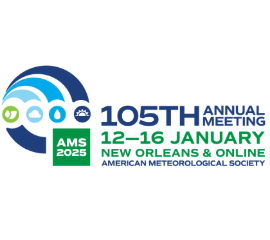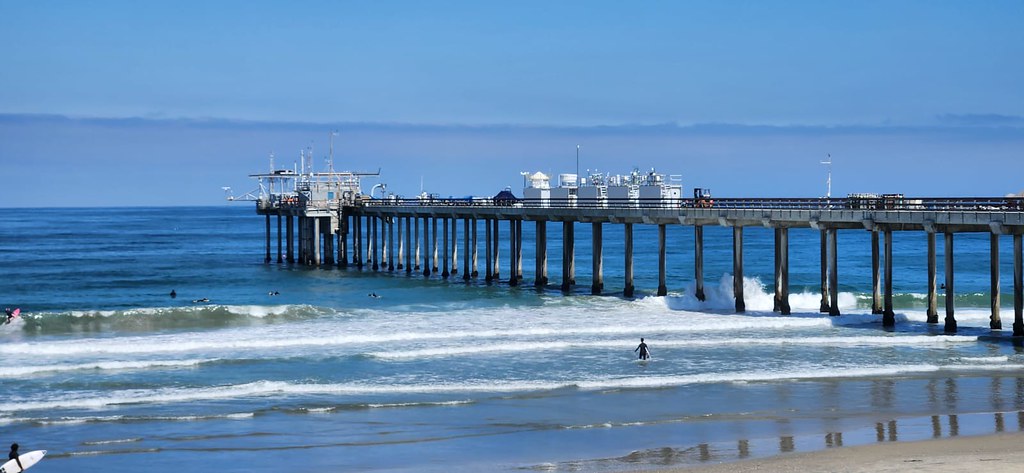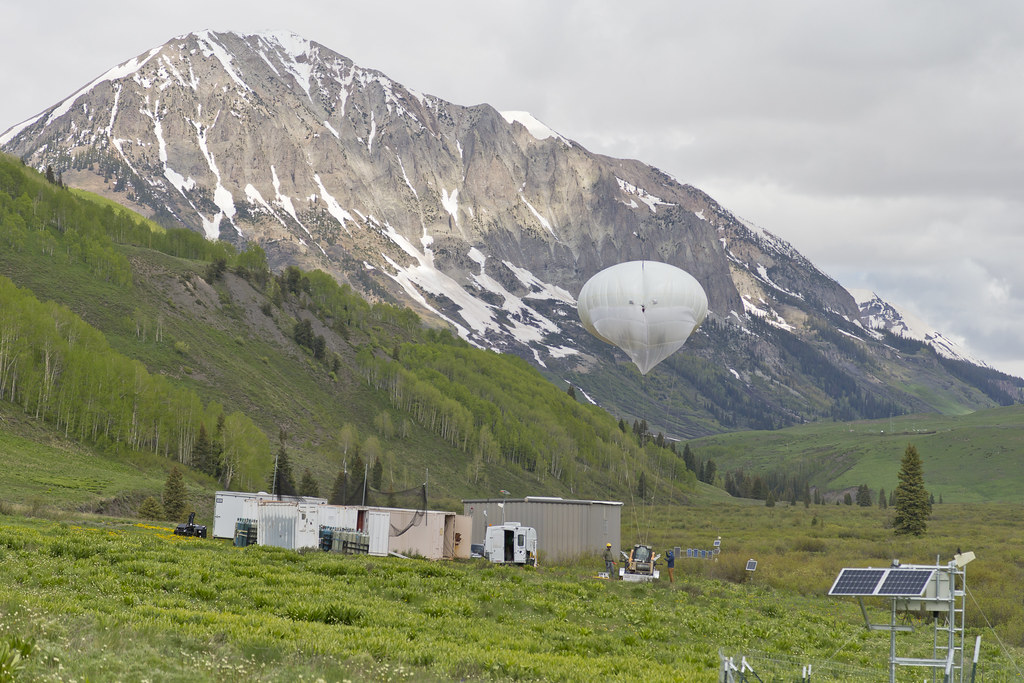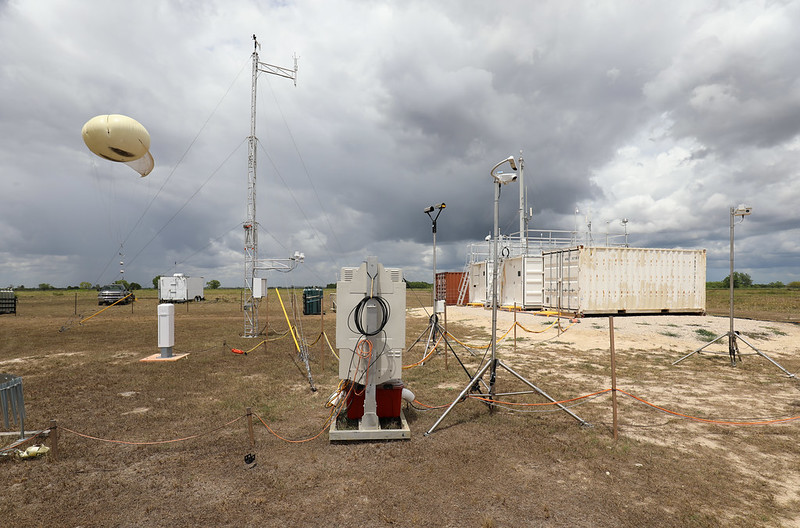2025 AMS Presentations Featuring ARM Data
Published: 3 January 2025
 The 2025 American Meteorological Society (AMS) Annual Meeting will be held from Sunday, January 12, to Thursday, January 16, at the Ernest N. Morial Convention Center in New Orleans, Louisiana, and online. With more than 7,000 attendees expected, the meeting might feel overwhelming. We make it easy for you to find ARM-relevant science, meet up with colleagues, and discover new connections during the event.
The 2025 American Meteorological Society (AMS) Annual Meeting will be held from Sunday, January 12, to Thursday, January 16, at the Ernest N. Morial Convention Center in New Orleans, Louisiana, and online. With more than 7,000 attendees expected, the meeting might feel overwhelming. We make it easy for you to find ARM-relevant science, meet up with colleagues, and discover new connections during the event.
Below is a list of ARM-related AMS meeting highlights (all times Central). Information is subject to change; please check the AMS Annual Meeting website for the most up-to-date information.
Discover more ARM-related presentations and posters, as well as sessions, talks, and posters related to Atmospheric System Research (ASR).
Add your presentation to be featured on the ARM or ASR presentation web pages.
Attending AMS in person? Make sure to visit the ARM table (#51) at the Career Resource and Graduate School Fair on Saturday, January 11, from 5 to 7 p.m. in Hall C (open to Student Conference attendees only), and Sunday, January 12, from 6:30 to 8:30 p.m. in Hall B (open to all AMS attendees).
U.S. Department of Energy (DOE) Updates
- Agency Updates Session: DOE Plans for Atmospheric Research on Ships of Opportunity
Monday, January 13, 12:15–1:15 p.m., Room 226 (Convention Center)
Session Chair: Shaima Nasiri, DOE
Presenters: Shaima Nasiri, DOE; Raghavendra Krishnamurthy, Pacific Northwest National Laboratory; Lynn M. Russell, University of California, San Diego; Derek Coffman, NOAA
Check out ARM-Related Presentations:
Town Halls
Related Interagency Town Halls
- The U.S. Climate Modeling Summit (USCMS) – Decadal Retrospective and Looking Forward
Monday, January 13, 12:15–1:15 p.m., Room 343 (Convention Center)
Primary Contact: Gerald L. Geernaert, DOE
Presenters: Gerald L. Geernaert, DOE and Vijay S. Tallapragada, NOAA
- Interagency Coordination for Meteorological Services in an Era of Rapid Technological Advancements
Thursday, January 16, 12:15–1:15 p.m., Room 342 (Convention Center)
Primary Contact: Daniel J. Melendez, NOAA
Presenter: Joseph J. Cione, NOAA
ARM-Related Presentations
Oral Presentations
Please note: On average, each oral presentation is scheduled to run no longer than 15 minutes, so full session times are listed below for planning purposes.
- 10.5: ACTing on Atmospheric Data: Leveraging Open-Source Software for Field Campaigns and Beyond. Zachary Sherman, Argonne National Laboratory.
Wednesday, January 15, 10:45 a.m.–noon, Room 213 (Convention Center)
- 12.2: ARM Open Science Summer School 2024: Connecting State-of-the-Art Models with Diverse Field Campaign Observations with Open Science. Maxwell A. Grover, Argonne National Laboratory.
Wednesday, January 15, 4:30–6 p.m., Room 213 (Convention Center)
- J13A.4: DOE ARM LASSO Activity: Progress on ENA Maritime Cloud Scenario. William I. Gustafson, Pacific Northwest
National Laboratory.
Thursday, January 16, 8:30–10 a.m., Room 215 (Convention Center)
Invited Presentations
Please note: On average, each presentation is scheduled to run no longer than 15 minutes, so the full session times are listed below for planning purposes.
Oral Presentations
- J4A.1: Unveiling the Interaction Between Aerosols and Deep Convection Through Joint Cell-Thermal Tracking Analysis of Large Eddy Simulations From the TRACER Field Campaign. Toshi Matsui, NASA Goddard Space Flight Center/University of Maryland,
College Park.
Monday, January 13, 4:30–6 p.m., Room 215 (Convention Center)
- J4B.3: Comparison of Relationships Between Aerosol Size Distributions and Cloud Supersaturations Over the North Atlantic Ocean. Lynn M. Russell, University of California, San Diego.
Monday, January 13, 4:30–6 p.m., Room 220 (Convention Center)
Featured Field Campaign Presentations
Eastern Pacific Cloud Aerosol Precipitation Experiment (EPCAPE)

The Eastern Pacific Cloud Aerosol Precipitation Experiment (EPCAPE), which kicked off in La Jolla, California, in February 2023 and ran through February 2024, explored aerosol indirect effects on stratocumulus clouds to help improve their representation in earth system models. EPCAPE included the deployment of an ARM Mobile Facility on the Ellen Browning Scripps Memorial Pier and a scanning cloud radar on Mount Soledad less than a mile inland.
As part of EPCAPE, researchers will explore how pollution from the nearby Los Angeles metropolitan area affects marine aerosols and, by extension, the clouds near San Diego.
- ORAL SESSION—J5A: Aerosol-Cloud Interactions in Warm Clouds I
Joint session with the 17th Symposium on Aerosol Cloud Climate Interactions and the Second Symposium on Cloud Physics
Tuesday, January 14, 8:30–10 a.m., Room 215 (Convention Center)
Reported EPCAPE presentations:- J5A.4: Aerosol-Cloud Interactions of Stratocumulus in the Eastern Pacific Marine Boundary Layer. Allison C. Aiken, Los Alamos National Laboratory.
- J5A.5: Aerosol-Correlated Activation and Supersaturation Variability in Low-level Coastal Marine Stratus During EPCAPE.
Jeramy L. Dedrick, University of California, San Diego.
- ORAL SESSION—J14A: Formation and Impacts of Aerosols and CCN: Experiment, Observation, and Modeling I
Joint session with the 17th Symposium on Aerosol Cloud Climate Interactions and the 27th Conference on Atmospheric Chemistry
Thursday, January 16, 10:45 a.m.–noon, Room 215 (Convention Center)
Reported EPCAPE presentation:- J14A.3: Chemical Composition of the Droplet Residuals of Coastal Low-level Clouds During EPCAPE. Abigail Williams,
University of California, San Diego.
- J14A.3: Chemical Composition of the Droplet Residuals of Coastal Low-level Clouds During EPCAPE. Abigail Williams,
Surface Atmosphere Integrated Field Laboratory (SAIL)

The Surface Atmosphere Integrated Field Laboratory (SAIL) field campaign, which operated from September 2021 to June 2023, took place in the 300-square-kilometer (116-square-mile) East River Watershed near Crested Butte, Colorado. As part of SAIL, an ARM mobile observatory provided valuable atmospheric data that researchers can use to develop detailed measurements of mountainous water-cycle processes pertaining to the Colorado River, which supplies water for 40 million people in the Western United States.
Through SAIL, researchers from national laboratories, universities, research centers, and agencies are gaining an atmosphere-through-bedrock understanding of mountainous water cycles.
- ePOSTER SESSION—Wednesday ePosters
Wednesday, January 15, 3–3:40 p.m., Hall C (Convention Center)
Reported SAIL presentation:- E60: 39HYDRO Analysis of Cold Season Precipitation Dynamics in Complex Terrain Over the Upper Colorado River Basin.
Sierra Liotta, University of Colorado, Boulder.
- E60: 39HYDRO Analysis of Cold Season Precipitation Dynamics in Complex Terrain Over the Upper Colorado River Basin.
- ORAL SESSION—J12A: Climatological Observing Needs From the Ground Up: Advancements in Soil Moisture and Aerosol Measurements, Observations, Retrievals, and Applications
Joint session with the 25th Symposium on Meteorological Observation and Instrumentation and the 29th Conference of Applied Climatology
Wednesday, January 15, 4:30–6 p.m., Room 355 (Convention Center)
Reported SAIL presentation:- J12A.5: Aerosol Vertical Distributions Detected by an HSRL During ARM SAIL Campaign. Peng Wu, Pacific Northwest
National Laboratory.
- J12A.5: Aerosol Vertical Distributions Detected by an HSRL During ARM SAIL Campaign. Peng Wu, Pacific Northwest
SAIL’s lead scientist, Daniel Feldman, is chairing the following SAIL-related AMS session:
- ORAL SESSION—9C: Field Observations, Remote Sensing, and Modeling of Hydrology and Its Change in High-Altitude Complex Terrain
Joint session with the 39th Conference on Hydrology and the 25th Symposium on Meteorological Observation and Instrumentation
Wednesday, January 15, 8:30–10 a.m., Room 221 (Convention Center)
Reported SAIL presentations:- 9C.1: The Short Life of Upvalley Wind during the Warm Season in Colorado’s East River Valley. Bianca Adler, Cooperative Institute for Research in Environmental Sciences.
- 9C.2: The Impact of Dust in Snowfall on Snow Albedo in the Upper Colorado River Basin. Daniel Feldman, Lawrence Berkeley National Laboratory.
- 9C.3: Surface Quantitative Precipitation Estimates (SQUIRE) from the X-Band Precipitation Radar during the Surface Atmosphere Integrated Field Laboratory (SAIL) Experiment. Robert C. Jackson, Argonne National Laboratory.
TRacking Aerosol Convection interactions ExpeRiment (TRACER)

The TRacking Aerosol Convection interactions ExpeRiment (TRACER), which ran from October 2021 through September 2022, provided convective cloud observations with high space and time resolution over a broad range of environmental and aerosol conditions in the Houston, Texas, region.
As part of TRACER, ARM deployed a mobile observatory southeast of downtown Houston, a scanning precipitation radar south of downtown, and an ancillary site southwest of the city, where tethered balloon systems were launched. Together, these ARM measurements are helping researchers better understand the variability of aerosols and meteorology between the urban Houston area and surrounding rural environments.
- ORAL SESSION—Session 1: Lightning and Cloud Processes: Microphysics, Electrification, Thunderstorm Kinematics, Dynamics, and Lightning I
Monday, January 13, 8:30–10 a.m., Room 219 (Convention Center)
Reported TRACER presentation:- 1.1: Delving into the Charge Structure and Evolution of Deep Convection in Clean and Polluted Environments Along the Texas Gulf Coast Region. Timothy Logan, Texas A&M University.
- VIRTUAL POSTER SESSION—Virtual Poster Slam Session #1
Tuesday, January 7, 1–2 p.m., Virtual
Reported TRACER presentation:- V1: 17AEROSOL How Well Does the SCREAM Simulate Deep Convection During the TRACER? Youtong Zheng, University of Houston.
- ORAL SESSION—Session 12: Convective Evolution: Processes, Dynamics, Environment, and Links to Weather and Climate II
Wednesday, January 15, 4:30–6 p.m., Room 224 (Convention Center)
Reported TRACER presentation:- 12.4: Convective Cloud Lifecycle and Merging Behavior in Sea-Breeze Environments: Insights from TRACER Observations and WRF Simulations. Dié Wang, Brookhaven National Laboratory.
- ORAL SESSION—J11A: R2O2R Activities and Testing
Joint session with the 33rd Conference on Weather Analysis and Forecasting, the 29th Conference on Numerical Weather Prediction, and the 15th Conference on Transition of Research to Operations (15R2O)
Wednesday, January 15, 1:45–3 p.m., Room 206 (Convention Center)
Reported TRACER presentation:- J11A.5: Evaluation of Convection-allowing Model Ensemble Members Using a Network of Planetary Boundary Layer Observations from the TRACER Field Campaign. Francesca Marie Lappin, University of Oklahoma.
- ORAL SESSION—Session 13B: Convective Evolution: Processes, Dynamics, Environment, and Links to Weather and Climate III
Thursday, January 16, 8:30–10 a.m., Room 212 (Convention Center)
Reported TRACER presentation:- 13B.4: Novel Strategies for Radar Scanning and Convection Tracking to Study Isolated Deep Convection. Dié Wang,
Brookhaven National Laboratory.
- 13B.4: Novel Strategies for Radar Scanning and Convection Tracking to Study Isolated Deep Convection. Dié Wang,
- POSTER SESSION—Formation and Impacts of Aerosols and CCN: Experiment, Observation, and Modeling
Thursday, January 16, 3–4:30 p.m., Hall C (Convention Center)
Reported TRACER presentation:- 984: Probing the Potential Drivers of New Particle Formation and Growth During TRACER in Houston, TX.
Samuel Emmart O’Donnell, Colorado State University.
- 984: Probing the Potential Drivers of New Particle Formation and Growth During TRACER in Houston, TX.
- ORAL SESSION—J14A: Formation and Impacts of Aerosols and CCN: Experiment, Observation, and Modeling I
Joint session with the 17th Symposium on Aerosol Cloud Climate Interactions and 27th Conference on Atmospheric Chemistry
Thursday, January 16, 10:45 a.m.–noon, Room 215 (Convention Center)
Reported TRACER presentation:- J14A.4: Observation of Particulate Matter as a Proxy for Cloud Condensation Nuclei. Sonia Fanysia Durgan, Brookhaven National Laboratory.
TRACER’s lead scientist, Michael Jensen, is co-chairing the following TRACER-related AMS sessions:
- ORAL SESSION—Session J3A: Aerosol-Cloud Interaction in Deep Convection I
Monday, January 13, 1:45–3 p.m., Room 215 (Convention Center)
Reported TRACER presentations:- J3A.4: Aerosol–Cloud Interactions during GoAmazon and TRACER: Does Deep Convection Respond to Pollution Similarly in the Tropics and Sub-Tropics? Hannah C. Vagasky, Atmospheric and Environmental Research.
- J3A.5: Sensitivity of isolated deep convection to TRACER thermodynamic and aerosol environments in idealized simulations. Anita D. Rapp, Texas A&M University.
- POSTER SESSION—Aerosol-Cloud Interaction in Deep Convection
Monday, January 13, 3–4:30 p.m., Hall C (Convention Center)
Reported TRACER presentations:- 166: Causal Analysis of Aerosol Impacts on Isolated Deep Convection: Findings from TRACER. Dié Wang, Brookhaven National Laboratory.
- 168: Dependence of Convective Cell Properties on Meteorological and Aerosol Conditions During TRACER. Dhwanit J. Mise, University of Oklahoma/Cooperative Institute for Severe and High-Impact Weather Research and Operations.
- 169: Properties of Convective Outflow During the TRacking Aerosol Convection interactions ExeRiment (TRACER) Campaign. Jordan Love Newton, Brookhaven National Laboratory.
- ORAL SESSION—Session J4A: Aerosol-Cloud Interaction in Deep Convection II
Monday, January 13, 4:30–6 p.m., Room 215 (Convention Center)
Reported TRACER presentation:- J4A.1: Unveiling the Interaction between Aerosols and Deep Convection Through Joint Cell-Thermal Tracking Analysis of Large Eddy Simulations from the TRACER Field Campaign (Invited). Toshi Matsui, NASA Goddard Space Flight Center/
University of Maryland, College Park.
- J4A.1: Unveiling the Interaction between Aerosols and Deep Convection Through Joint Cell-Thermal Tracking Analysis of Large Eddy Simulations from the TRACER Field Campaign (Invited). Toshi Matsui, NASA Goddard Space Flight Center/
Keep up with the Atmospheric Observer
Updates on ARM news, events, and opportunities delivered to your inbox
ARM User Profile
ARM welcomes users from all institutions and nations. A free ARM user account is needed to access ARM data.


















